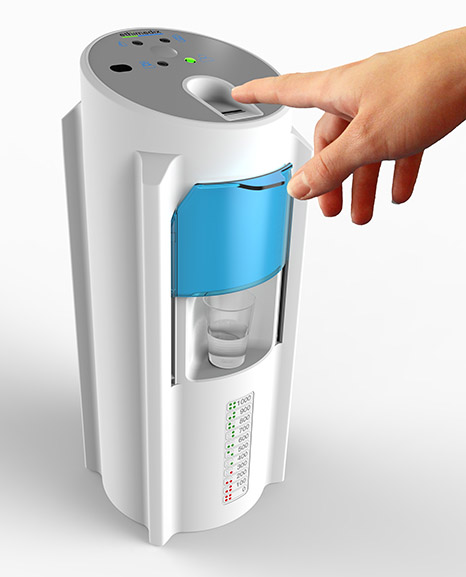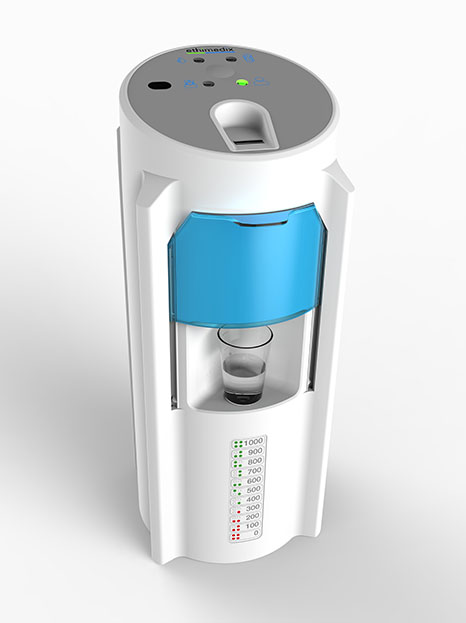
Ethimedix, a Swiss medical device company, has developed the SmartBottle, a drug administration device for analgesics. The device is a programmable “lockbox” which allows for the controlled administration of single doses of opioid painkillers, reducing the potential for addiction and abuse.
In view of the current opioid crisis, controlling access to prescription analgesics is important. The FDA has launched an Innovation Challenge to incentivize companies to develop medical devices that can combat the opioid crisis. Ethimedix have recently submitted their SmartBottle for consideration in the challenge.
The SmartBottle dispenses drinkable liquid morphine and employs a variety of security measures. These include biometric fingerprint authentication to ensure that only authorized patients or healthcare providers can access the medication.
The device also incorporates a tamper-proof cartridge, and if the dispenser detects a breach it will immediately flash-neutralize the medication, rendering it useless. The dispensers have already been tested in French hospitals, and the company plans to market them in the US.
Medgadget asked Leila Smith, scientific and business consultant at Ethimedix, some questions about the system.
Conn Hastings, Medgadget: Please give us some background on the scale and impact of the current opioid crisis and the need for better pain management.

Leila Smith, Ethimedix: Overdose by drugs is the leading cause of death of Americans under 50, with two-thirds of those deaths from opioids. Opioids were responsible for 49,000 of the 72,000 drug overdose deaths overall in the U.S. in 2017 (for all ages).
This is a tragic reality for many families in the U.S. In fact, many people know someone, or of someone, who has died as a result of an overdose, accidental or otherwise. The cost to society is not only very high but is sky rocketing: according to Altarum.org, the “Economic Toll of the Opioid Crisis in the U.S. has exceeded $ 1 Trillion since 2001.”
In May 2018, President Trump declared the opioid crisis a national emergency and issued a directive to his administration to use all “appropriate emergency and other authorities to respond to the crisis caused by the opioid epidemic.”
On October 3, 2018, the Senate passed the final version of a sweeping opioids package, signed on October 24, 2018 by President Trump. The Washington Post called out “one of Congress’s most significant legislative achievements this year, a rare bipartisan response to a growing public health crisis that resulted in 72,000 drug-overdose deaths last year.”
In large part, the opioid crisis is due to the rapid increase in the use of prescription and non-prescription opioid drugs in the U.S. and Canada, beginning in the late 1990s, which has continued to increase dramatically since then. This is where our SmartBottle can make a difference: by regulating and controlling access to the prescribed opioid, the patient’s ability to increase his or her usage, and access by family and friends is thwarted.
Medgadget: Please give us an overview of how the SmartBottle works and the treatment it dispenses.
Leila Smith: The SmartBottle is programmed to deliver only the right dose of opioid at the right time to the right patient and only for the prescribed duration of treatment. It is very easy for the patient to use: he or she only needs to pass his/her fingerprint on the device’s detector to receive medication at the allowed intervals. The actual set up is the work of the pharmacist, who will fill the device’s pouch with as much medication as needed for the duration of the treatment, up to 1 month. Using an encrypted key to access the easy-to-use program on the SmartBottle’s chip, the pharmacist will capture the patient’s fingerprint, and enter the prescription (exact volume to be dispensed, intervals authorized, and duration of the treatment whether in hours, days, weeks). Once the treatment is terminated, or outside of the authorized intervals, the bottle simply will no longer dispense any medication. Any attempts to access the opioid will trigger the flash neutralization function.
Medgadget: Is the SmartBottle envisaged as a device that a patient can bring home with them, or as a dispensing solution for staff in healthcare facilities?
Leila Smith: It can do both.
In one case, the patient can take the SmartBottle home and no longer have to worry about opioid misuse by himself/herself or others in the circle of family and friends. Additionally, if the patient forgets that he/she has already taken it, the SmartBottle will not dispense the medication if it is too close to the previous dose, as per the embedded prescription.
It can also be used in what we call the “Hospital” or “Team” mode, whereby the fingerprints of the healthcare professionals at work on the ward are captured on the SmartBottle’s chip, allowing them to safely keep the device on their treatment cart without fear of theft or diversion. This is the current use at the Kremlin Hospital in Paris, where more than 20 SmartBottles are already in use to facilitate efficient pain relief for patients as the healthcare providers do their rounds, without having to run back and forth looking for the key to the safe that holds the opioid pain medication. This saves them up to 1 hour per shift.

Medgadget: So, how do the security mechanisms (biometric authentication and flash-neutralization) in the device work? How do these help to prevent or reduce opioid abuse?
Leila Smith: Because the prescription is programmed into the SmartBottle’s chip, the patient cannot take more than prescribed, whether by accident or by design. If the patient needs to increase his/her daily medication (whether in quantity or in frequency), he/she will need to contact the treating doctor or authorized healthcare professional. This reduces the risk of a slow but regular increase in dosage and ensuing addiction, which too often leads to accidental overuse and overdose. The SmartBottle ensures total control of the dosage, something that is impossible today with pills, tablets, or drops. It also keeps it safe from others around the device.
The biometric authentication involves the patient’s fingerprints, which are captured at the time of pickup. This is performed by the delivering pharmacy (hospital or private) under strict control and regulation, as is the case today with pills and tablets – but with the additional level of control and security offered by this authentication system coupled with the programmed dispensing schedule.
Lastly, the flash neutralization is a very clever, patented functionality. The minute the bottle is locked by the pharmacist, any attempts to alter the integrity of the bottle will trigger the flash neutralization. The module that serves to neutralize the opioid in case of tampering is located next to the pouch holding the medication, and is linked to the SmartBottle’s electronics. If tampering occurs the neutralization substance is released into the liquid drug solution where it rapidly binds to the opioid, rendering it totally unusable for drinking or injecting.
Medgadget: The device has already been trialed in French hospitals. How has the unit been received in this context?
Leila Smith: Every time I speak to our main contact at Kremlin Hospital, Dr. I. Nègre, she reminds me that our SmartBottle is not only accepted and adopted by the healthcare providers, but that they do not want to go back to their old opioid dispensing system! In fact they want to expand the use of it.
I met with two of the nurse users myself and they just love it. Not only is it a time saver, as they do not have to run around looking for a key, getting just the one dose out of the opioid pills/tablets cabinet for one patient at a time, then locking up again and picking up where they left off in their round with great peace of mind. The SmartBottle device sits on their cart, day and night, without worry about theft, abuse, misuse, and diversion and yet available, with their fingerprint, when pain relief is needed for their patients.
Thanks to the monitoring program, whether the SmartBottle is used at home or at the hospital, the log book records any and all uses, and the time of dosage.
Medgadget: Please give us an overview of how the FDA Innovation challenge ties in with your plans to market the product in the US.
Leila Smith: Our device, because it is an abuse-deterrent, and controls dispensing to only authorized patients, could help to save lives immediately if it was available in the U.S., as well as globally.
To perform the very first regulatory step, which is a real-life test of our device using an opioid drug that is both FDA approved for pain relief and meets our device’s specifications, we need the FDA’s guidance both in terms of a preferred protocol for testing and in selecting the medication of choice for this test.
The FDA’s fast tracking program, made possible by the Innovation Challenge, would allow us to move more rapidly, making sure our SmartBottle is implemented for the best immediate use and to help mitigate the current opioid crisis.
Beyond that, Ethimedix is also looking to partner with a company that could offer a strong manufacturing and commercialization arm in the US to help reach a wide group of patients for whom the SmartBottle is the ideal source for safe, controlled, pain relief. We believe that the FDA Challenge can give us wide exposure to these kinds of partners, which will in turn expedite market access for the SmartBottle.

Product page: SmartBottle…
